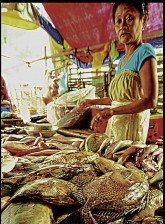BFAR says bid to breed ‘malaga’ is successful

“MALAGA” is among the assortment of fish being sold at the Bani public market in Pangasinan. EV ESPIRITU/INQUIRER NORTHERN LUZON
ALAMINOS CITY—The production of malaga (siganid), one of the high-value fish species in the country, will soon intensify after the Bureau of Fisheries and Aquatic Resources (BFAR) successfully bred the fish in captivity.
Nestor Domenden, BFAR regional director, said the Regional Mariculture Technology and Demonstration Center (RMTDC) at the Hundred Islands National Park here has generated an effective technology for inducing malaga to spawn using hormones.
“This is to support the aquaculture industry, which is dependent on the wild for fingerlings. At present, 99.9 percent of malaga fingerlings cultured in cages or ponds come from the wild, but with the developed technology, fishermen don’t have to rely on the wild, where spawning is seasonal, for their stock,” Domenden said.
Long-term effects
“Besides, there is a need to conserve the fish in the wild because we could lose the species in the long run because of the high extraction rate,” he said.
Article continues after this advertisementThe BFAR-RMTDC is focused on breeding malaga, aside from sea cucumber and abalone, because of the growing demand for high-value fish in the country, he said.
Article continues after this advertisementThe RMTDC started to breed malaga in May and it was the second time that the breeders spawned.
“So we are confident that we have the effective technology as we are using the same spawning protocol,” said Domenden.
For the first batch, the facility produced more than 3,000 fingerlings while for the second batch, it produced 15,000 to 20,000 fingerlings, which are now 70 days old.
Ready for distribution
After 70 days, the fish are ready for stocking in bodies of water like rivers, the sea and ponds, he said.
The center breeds two species of siganid—Siganus guttatus (its skin has spots) and Siganus vermicullatus (its skin has lines). They are considered sexually mature at eight months and are acclimatized at the hatchery for five months, after which they develop eggs (female) and milt (male).
Domenden said the center also needs to decongest the breeding tanks.
“So we are planning to give the excess fingerlings to selected, qualified fish growers and release the others into the sea,” he said.
“We cannot sell the fingerlings yet because we are at the level of testing of performance of hatchery-bred juvenile malaga,” he said.
Training
The BFAR intends to commercialize the spawning technology and will train fishery technicians and people who want to establish their own hatcheries.
Domenden said this was the first time that malaga was bred in captivity in Luzon but there were efforts by Mindanao State University to develop a spawning technology in the past. Yolanda Sotelo, Inquirer Northern Luzon